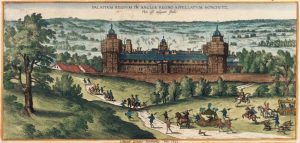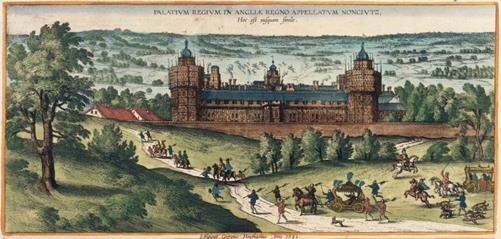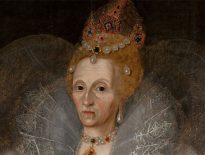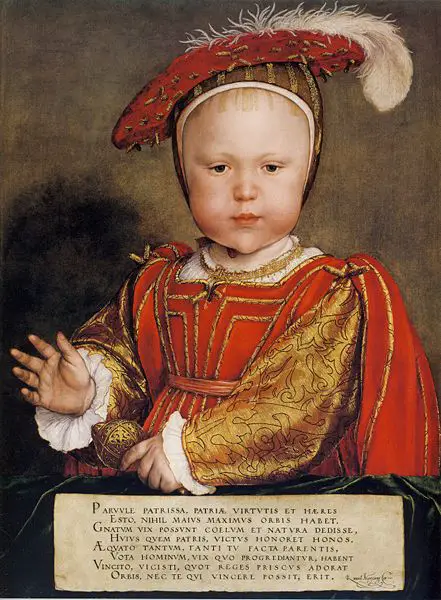Thank you so much to Tudor Society member Nancy for asking this question: "If the queen had to make a potty stop between residences, how would that be accomplished? Does anyone know?"
Social historian and re-enactor Bess Chilver has answered Nancy's question, taking into account what a king would do as well. Over to Bess...
Very interesting question. Our perception of a Royal, even now in these times of minimal deference, is that of a figure, remote and almost not human. Or at least, not subject to the usual human frailties and bodily functions.
However, even a King or a Queen needs to use the (Royal) Potty sometimes, so where did they use it?
Within their own properties, there were rooms specifically for their own private use. The Close Stool or Privy was the Medieval and 16th-century versions of the modern toilet. Mostly they worked in a similar way to a modern composting toilet except that the contents of the toilet would be removed by the night soil men. The effluent would be used for composting elsewhere - an excellent example of recycling.
The Monarch had many properties within and close to London:- Palace of Placentia in Greenwich; The Tower of London; Richmond Palace; Nonsuch Palace; Whitehall Palace; The Tower of London etc. It is unlikely then, that between palaces within London or the surrounding areas, that the King or Queen would be “caught short”. If so, they would probably wait till they arrived at their destination which would not be that far.
On a Royal Progress, where the Monarch is travelling around the country, there is always the possibility of needing to obey one's bodily functions. Unfortunately, we don't know (or haven't yet found) the precise answer to what would have happened. We can extrapolate and surmise what *could* have happened though, based on the logistics of a Royal Progress.
It is useful to understand what a Royal Progress was. In a time period where the vast majority of the population would never see their monarch, this was the opportunity to show oneself to as many of one's subjects as possible. It was also a possible way to provide favour to beloved and loyal courtiers and maybe also to put more maverick or uppity courtiers in their place by hitting them in their pocket under the guise of the favour of a Royal Visit. Many a courtier could be bankrupted by the costs involved in hosting the Queen or King for a couple of days. The Progress also allowed for the Royal Palaces to be cleansed thoroughly in the Monarch's absence and also for the Monarch to avoid the hot London atmosphere and possible infections that may be making the rounds.1
Focussing on Queen Elizabeth's Progresses, as these are best documented, it is easy to see from the itineraries that exist and the maps that have been created linking the destinations, that there was never really any very long period of time before the Court and the Queen would arrive at a destination. The 1591 Progress into Sussex is a good example as it was a 6-week-long progress. It started on on Monday 2nd August 1591 at Nonsuch Palace. Tuesday 3rd August there were two stops: East Horsely and Leatherhead. Short stop in Guildford on Wednesday 4th August and then a longer stay from 5th to the 9th August at Loseley, hosted by Sir William More. Other destinations were Farnham Castle (Bishop of Winchester); Cowdray (Viscount Monatgue), Chichester (Lord Lumley) and many others.2
Using Googlemaps, the first 2 weeks of the progress is as follows:
|
Date |
Starting point |
Destination |
Duration |
Miles |
| Mon 2nd Aug 1591 | Nonsuch Palace | East Horsely/Leatherhead |
1 day |
13 |
| Tue 3rd Aug 1591 | East Hosely/Leatherhead | Guildford |
1 day |
6 |
| Wed 4th Aug 1591 | Guildford | Loseley (5 to 9 Aug) |
5 days |
3 |
| Mon 10th Aug 1591 | Loselely | Farnham Castle |
4 days |
10 |
| Sat 14th Aug 1591 | Farnham Castle | Bramshott |
1 day |
12 |
Medieval monarchs often travelled around 35-45 miles per day3 on their progresses. By the 16th century the Progress is more leisurely and the distances travelled in a day are shorter – approximately 10 to 12 miles per day.4 Time needed to be allocated for arrival: unpacking, setting up tents for the servants and lesser courtiers; arranging quarters for the elite members of the Court and the Queen herself, allowing plenty of time for cleansing and refreshing oneself before dining with the hosts and entertainments.
Though it is probably impossible to say for certain what would happen if the Queen (or King) needed to stop for a comfort break between properties, it is likely that the time for travel was “built in” to the itinerary to ensure comfort breaks could be taken at the next destination. The logistics of travel involved a huge baggage train – carts filled with items that were necessary for the Queen's comfort. These would have covered the Royal Household items such as furniture (including beds and bathtubs); bedding and household linens; clothing from the Royal Wardrobe, Tapestries and wall hangings; kitchen ware as well as the paraphernalia for the business of government to continue.5 Tents and pavilions would also be brought along, though, as the number of persons to provide accommodation and sleeping areas would preclude all a space in the houses visited. Tents would be used for the lesser courtiers and servants.
It is reasonable to assume if furniture and kitchenware, tents and tapestries etc are in the baggage train, then a bathtub and the Royal Potty will be included as well. It's very possible there were a number of pots for the call of nature and one may very well be on hand for the Queen's use on the road. Supposition suggests that if there are tents, then there could well be a canvas screen easily and quickly erected for the Queen's privacy if needed.
In conclusion, though we cannot confirm precisely what the Queen/King did when on the road, we can safely assume that it was thought of in terms of the itinerary, the shorter distances travelled between destinations and Sir William Cecil's obsession with lists and organisation that is very likely to have included the Royal Chamber Pot be available at a moments notice for the Queen's Comfort.
Bess Chilver has over 20 years experience as an historical re-enactor and costumer specialising in Tudor and Elizabethan history. Time travelling experience has extended to other time periods including the Medieval period, Victorian England (fluffy Bustle era) and WWI, mostly based at Kentwell Hall in Suffolk.
As a re-enactor from whatever time period, Bess likes to ensure she has researched the time period, the role, social status and character as thoroughly as possible to provide as accurate as is possible portrayal for visitors. This includes researching and making the correct costume, learning the manners of the time, social history, politics (if suitable for her character) and sourcing appropriate accoutrements.
The research has paid off as Bess has also appeared in a number of historical documentaries over the years in variety of roles such as Anne of Cleves; a Lady in Waiting to Anne Boleyn, Mary Tudor and Queen Elizabeth I and also portraying Mary, Queen of Scots. In addition, Bess has provided lectures on social history for the Anne Boleyn Experience tour and on Costume at Costume College in Los Angeles.
It really is the closest to real time-travel one can get.
Notes
Picture: Elizabeth I arriving at Nonsuch, Franz Hogenberg after Georg Hoefnagel. Hand-colored engraving from Braun and Hogenberg’s Civitates Orbis Terrarum, ca. 1598. Folger Shakespeare Library.
- (Hill Cole, 1999)
- (Adams, 2012)
- Ibid.
- (Dovey, 1995)
- Ibid.
Bibliography
- Adams, C., 2012. Queen and Country: The Significance of Elizabeth I's Progress in Surrey, Sussex and Hampshire in 1591, University of Chichester: s.n.
- Archer, J. E., Goldring, E. & Knight, S. eds., 2007. The Progresses, Pageants and Entertainments of Queen Elizabeth I. Oxford: Oxford University Press.
- Dovey, Z., 1995. An Elizabethan Progress: The Queen's Journey into East Anglia 1578. s.l.:Sutton Publishing.
- Hill Cole, M., 1999. The Portable Queen: Elizabeth I and the Politics of Ceremony. USA: University of Massachusetts Press Amherst.





I have a question, why drag everything from one castle or place to another, like the beds and kitchen ware etc? why didn’t they just have everything they need in one castle or place and everything they need at the other places. So that every please they go, it would be furnished already and there would be no need to transport the whole castle and its contents from place to place.
Just wondering…
It’s funny, isn’t it? What a palaver, my mum would say! As far as I know, the properties were furnished, but there would have been items that the royal family expected to always be with them and were important for them to have when they visited a courtier’s home, for example. I guess having a castle sparsely furnished meant that it was easier to clean both before and afterwards. It just shows you what a mammoth undertaking a royal progress was and how bad weather and muddy roads could be a nightmare.
Some of these Kings like Henry Viii and Elizabeth didn’t like other beds. They had a bed which although a solid fixture, could be taken apart and moved from place to place. They also took their own locks. Even if someone got a bed made, the Queen may not turn up or still bring their own bed. The palace was then given a good scrub and made fresh for the return. It all seems like a great deal of fuss, but this was how they kept control, saw their people and avoided the plague in the hot capital. It was easier to move things around, everything was portable and they were used to it.
On going to the loo, Louis xiv believed it was a sign of weakness and he had a very large bladder. You only went if he did. There are stories of bursting ladies running into a corner on arrival as they were desperate and very uncomfortable.
On a documentary about life at Hampton Court when women in the eighteenth century had these ridiculous wide stiff skirts and had to go but were in attendance, they had a small portable device which they slipped under the skirt and were relieved.
Poor Henry Viii suffered from constipation and having not been able to go for two days, he took a purging mixture and at two in the morning it was reported that he gave the closed stool a goodly siege.
At least they had a portable loo.
Very interesting post 🙂
Hello Tisha,
Like many of us, we like our own “things” about us. A Royal Progress also does not necessarily mean travelling from ones own Royal Property to another. A Royal Progress usually means travelling to courtiers homes, therefore the Queen or King is likely to want to bring their own “stuff” with them. Henry VIII, if I rightly remember, had special locks for the doors to the private rooms assigned to him at each destination. Using these meant he knew who had access and no possibly unpleasant surprise visitors.
If travelling between Royal Palaces then most of what is needed will be at the destination. One of my recent roles in re-enactment events is portraying the Household of the Barons of Windsor of Bradenham. I play the Baroness (whoever she is in the “year” we portray at Kentwell Hall). The Baron (again whichever one we are portraying) has the hereditary office of “Keeper of Windsor Castle”. His responsibility is to ensure the Castle is fully equipped for whenever the Queen decided to come and stay.
When she decided to stay *at* Bradenham (in Buckinghamshire), she would have brought that baggage train with her. Poor Baron Windsor experienced this twice! Once in the 1560s and once in the 1570s! (Though I actually think they were very happy about it and wealthy enough that it not cause financial problems for the family judging by the fabulous painting of the 3rd Baron and his wife Lady Katherine (nee De Vere) and their first 4 children.
As a side note. The “Windsor Household” my husband and I portray consists of a “skeleton” crew of kitchen staff, upper servants: Gentleman Usher/Steward, pages, Liveried Musician, Companions, Tudors and “children”. We are seen at Kentwell’s events in pavilions….a Household on “progress” as it were. We have THREE huge pavilions plus awnings and an outside kitchen. The tents are properly furnished (we use furniture from our own house) such as a cupboard, chest, settle, tables, benches and sometimes even a bed. We have pewter plates, bowls, and goblets, silver flagons, Kitchenware and cookware, fireboxes and bring charcoal. One of the tents is also carpeted. We are echoing just a teeny bit what the Queen was doing….just we aren’t seen in transit but at our temporary destination.